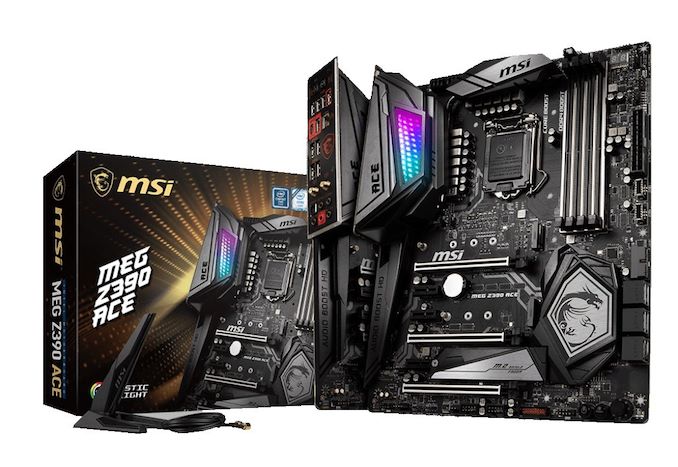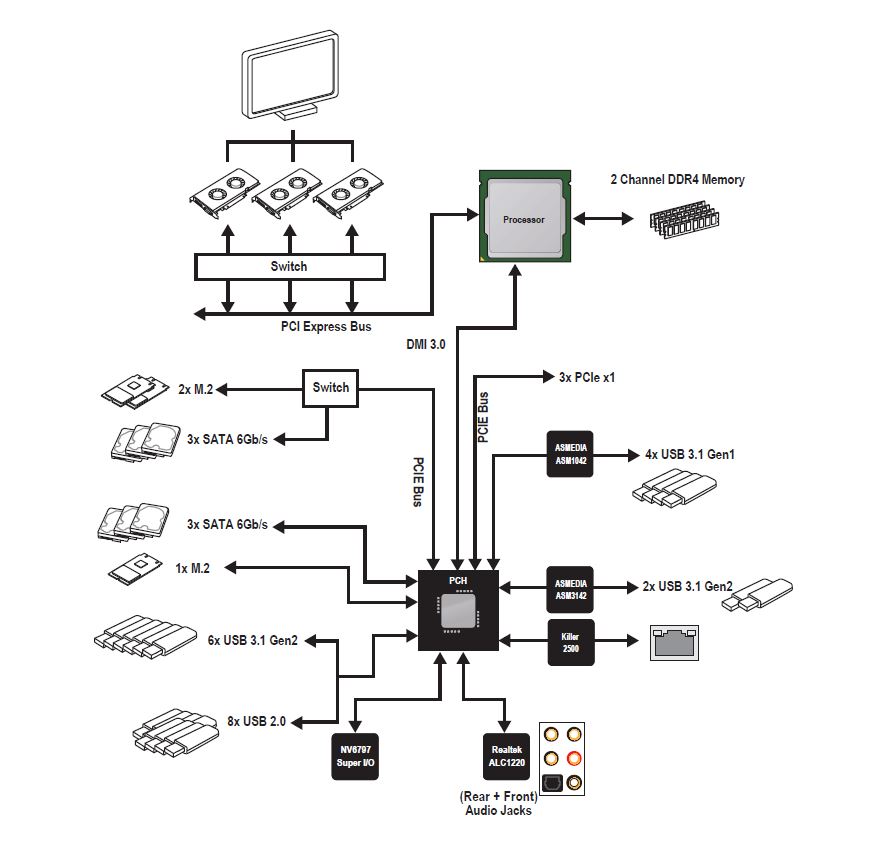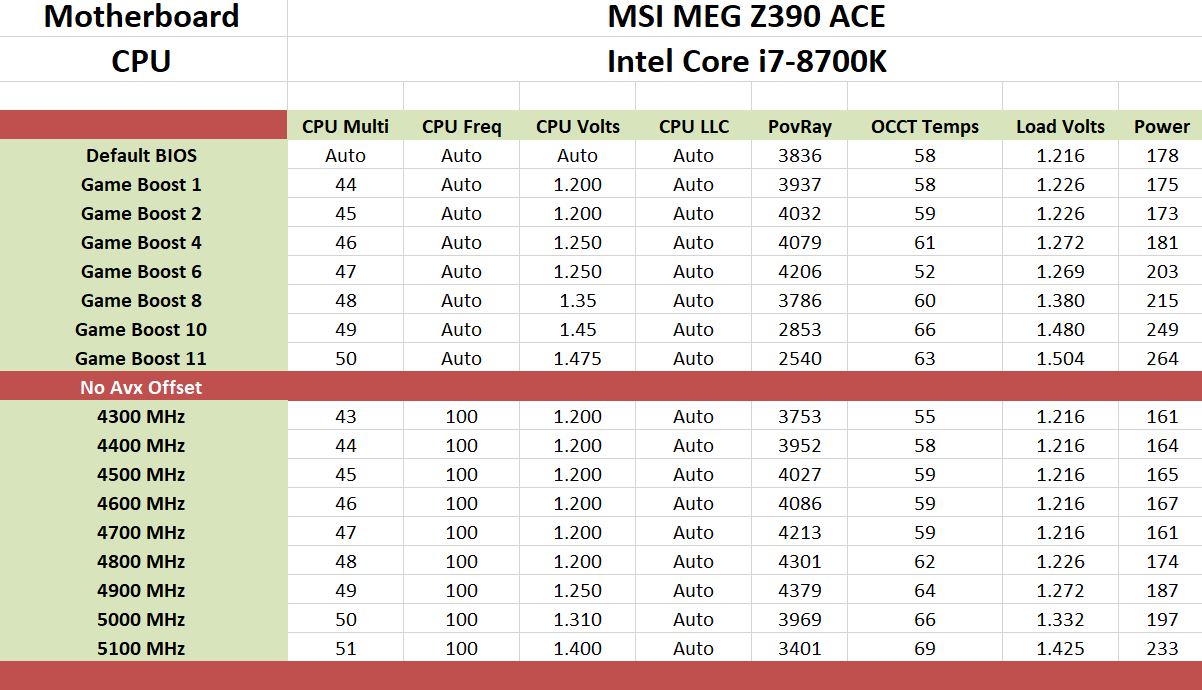The MSI MEG Z390 ACE Motherboard Review: The Answer To Your USB 3.1 Needs
by Gavin Bonshor on December 17, 2018 12:30 PM EST- Posted in
- Motherboards
- Intel
- Killer
- MSI
- Coffee Lake
- i7-8700K
- Z390
- ACE
- Z390 ACE

The MSI Z390 ACE sits below the MSI Z390 Godlike in the company's product stack and has plenty to shout about including a trio of M.2 slots, a well built power delivery, and as many USB 3.1 Gen 2 ports as you could ever need.
AnandTech 9th Gen CPU and Z390 Motherboard Coverage
- The Intel 9th Gen Review: Core i9-9900K, Core i7-9700K and Core i5-9600K Tested
- The ASRock Z390 Taichi Review: Jack of All Trades, Master of None
- Intel to Support 128GB of DDR4 on Core 9th Gen Desktop Processors
- Intel Z390 Motherboard Overview: 50+ Motherboards Analyzed
- GSkill Announces DDR4-4800 and DDR4-4500 Kits for Z390 Boards
The MSI MEG Z390 ACE Overview
The MSI Z390 ACE motherboard is aimed at gamers who are looking for premium features to create the foundations for a high-powered gaming system. In this case, MEG stands for 'MSI Enthusiast Gaming', which makes the first MSI redundant, and ACE doesn't stand for anything here, but MSI likes to make their brand names in ALL CAPS just like the GODLIKE so they pop out of the page when people scroll through the product list at Amazon or Newegg. Someone at MSI has put the marketing and naming into 'OVERDRIVE' (please don't make an all-caps motherboard called overdrive, please).
This model comes from MSI's premium product line, the Enthusiast Gaming range, and commands the weighty MSRP of $290. For that amount of money, MSI has to offer something special. The MSI Z390 ACE's core feature set includes four RAM slots with support for DDR4-4500 memory, three M.2 slots, six SATA ports, upgraded audio, a gaming focused 'Killer' network port, and the latest Intel Wi-Fi connectivity. On the design front, the Z390 ACE has a matte black PCB with a set of contrasting gunmetal grey heatsinks and a matching rear panel cover. The rear panel cover features an MSI Mystic Light Infinity panel which has a variety of customizable colors and effects which can be controlled by the MSI Mystic Light RGB software.
A quick glance at the specifications shows that the MSI Z390 ACE is a sub-set of the halo top-end MEG Z390 Godlike and is reflected in both the size and the in the price differences. The MSI Z390 ACE makes use of a Realtek ALC1220 HD audio codec and in keeping things consistent with a gaming flavor, MSI has also opted to use a Killer based E2500 Gigabit gaming LAN controller. In addition to this is the inclusion of an Intel 9560 802.11ac MU-MIMO Wave2 capable adapter which affords users both Wi-Fi and Bluetooth 5.0 connectivity.
Block diagram of the MSI Z390 ACE motherboard
On the technical front, MSI is advertising the Z390 ACE to contain a 13-phase power delivery. The heatsink attached itself has plenty of weight to it. The VCore/CPU section is running twelve ON Semiconductor high-side and low-side MOSFETs. This is controlled by an International Rectifier IR35201 PWM controller which is an 8-channel controller operating at 6+2. Each of the VCore phases features six individual doublers meaning the Z390 ACE is running a 6-phase design on the VCore. Providing power to the CPU is two 8-pin 12 V ATX power inputs while a standard 24-pin 12 V ATX input is there for to power the rest of the motherboards components.
With a total of three full-length PCIe 3.0 slots present, it is possible to run three-way CrossFire multi-graphics card setups on the Z390 ACE, but due to bandwidth limitations, a maximum of two NVIDIA cards in SLI can be accommodated. At the bottom right-hand of the PCB is an overclockers toolkit too. Cooling support is provided by seven 4-pin fan headers. USB 3.1 Gen2 ports are found on the rear panel, both Type-A and Type-C.
Looking at the performance of the MSI MEG Z390 ACE, nothing stands out as exemplary, although the most notable positives came in our 7-Zip encoding test and currently sits at the top of this benchmark. Another positive result came in our 3D Particle Movement and in POV-Ray, with comparable performance to other Z390 chipset boards on other tests. For system related tests such as POST time, the Z390 ACE sits middle of the road with a respectable time of just over 19 seconds; this was improved upon with controllers turned off in the BIOS by around 1 and a half seconds. Performance in other system-specific tests such as DPC Latency also sat middle of the road. The only real negative in our testing was in power consumption, which we explain in the review.
On the overclocking side of things, the MSI Z390 ACE performed well with manual overclocking, but ludicrous towards the upper end of the Game Boost profiles. As shown manually, we hit 5.0 GHz in our testing. There is plenty of headroom available for users looking to push their 8th and 9th generation processors beyond 5.0 GHz on this board, but the biggest factor in achieving this is keeping core temperatures as low as possible. Users with a 9900K might see better performance with the default solder-based thermal interface material.
The MSI Z390 ACE is one of two enthusiast specific MEG Z390 models which are aimed at the more premium end of the market. The other model in question is the MSI MEG Z390 Golike ($600) which sits right at the top of MSI's Z390 product stack for a sizable price. The Z390 ACE bridges the gap between the Z390 Godlike and the MPG Z390 Gaming Pro Carbon AC ($230) with a solid set of features. With a recommended retail price of $290, and the combination of specifications and aesthetics, MSI looks to woo users across multiple market areas.
Pages In This Review
- Overview [this page]
- Visual Inspection: Analysis of the Board Components
- BIOS and Software: Looking that the non-hardware portion
- Board Features and Test Bed: The full specification list, and how we test
- System Performance: Component testing, such as power, boot times, and DPC Latency
- CPU Performance
- Gaming Performance
- Conclusion














25 Comments
View All Comments
rsandru - Monday, December 17, 2018 - link
We're almost in 2019, can we move on beyond those 16 + 4 PCI-E lanes for the CPU please?I just want my GPU and M.2 storage connected directly to the CPU and not sharing bandwidth and latency with a million USB, SATA or audio ports and other traffic on the DMI uplink...
DanNeely - Monday, December 17, 2018 - link
I'd not hold my breath. Adding more PCIe lanes to the CPU would drive up die sizes and board costs for the >90% of systems that don't have a GPU.The only way I could see that happen is if Intel takes the CPU on Chipset stacking concept they showed at manufacturing day beyond the mobile demo to the desktop. Even then, I'd expect what they'd do is 16PCIe + ~8 configurable HSIO lanes so that entry level desktops could have 3-5x USB3, a 4/2 lane PCIe SSD and onboard wifi; either without needing a separate chip; or only with a tiny superbare bone chip to handle all the ultra-legacy and low bandwidth connections needed to control assorted chips on the board behind the scenes.
With that being a new manufacturing process though, I wouldn't expect to see it in the next year or two on the high volume mainstream desktop platform. Far more likely would be for it to launch as a premium option for top end laptop makers in the next year or two that trickles down over the to the rest of the market 2 or 4 years later.
DigitalFreak - Monday, December 17, 2018 - link
I agree, but the Intel/AMD response would be that you should look at HEDT / Threadripper if you need more CPU PCI-E lanes.Ryzen CPUs actually have 32 PCI-E lanes on the CPU, but the socket AM4 is only designed to for 16 GPU + 4 NVME + 4 to the SB. The other 8 aren't used. No idea why they didn't design AM4 to use all of them, unless it was for backwards compatibility with the pre-Ryzen CPUs.
DanNeely - Monday, December 17, 2018 - link
The problem is that both companies big socket platforms are a lot more expensive; and 90% of it is for things that are irrelevant to the average enthusiast; while both companies mainstream sockets fall a little bit short. Intel's by forcing SSDs into the DMI bottleneck; AMD's just in that their current chipset is a more or less obsolete piece of junk (eg only supporting PCIe 2.0). A combination of AMD's 20 non chipset lanes and a chipset approaching what Intel's are capable of would cover most of the gap between the mainstream platforms and enthusiast goals without going the budget busting route of the big sockets.Dunno that AMD's ever spoken about the unused 8 lanes. Could be cost reasons (would've made boards more expensive for legacy platforms); or even just to limit forward compatibility/confusion issues like the garbage fire Intel created when they had an LGA20xx generation that could have 16, 28, or 44 PCIe lanes and board makers either had to add a lot of extra complexity, have large chunks non-operational if using a low lane count chip, or ignore the potential of a number of lanes on the higher end chips.
namechamps - Monday, December 17, 2018 - link
It is backward compatibility. At this point one would think manufacturers would break that backwards compatibility (i.e. 2nd and 3rd m.2 slots not available for non-Ryzen processors).philehidiot - Monday, December 17, 2018 - link
So, please clarify this for someone who is not a computer scientist and is mildly drunk... if I buy a new Ryzen CPU, thinking I'm going to get 24 PCI-E lanes, I will in truth only be able to access 16, same as Intel? Or is it that I'd be able to access 24 whilst the CPU is designed for 32?DanNeely - Monday, December 17, 2018 - link
You can effectively use 20 lanes. The last 4 are used to connect the chipset on any but the lowest end boards which the CPU operate in SoC mode (and which probably will ignore the last 4 lanes entirely to save costs).tvanpeer - Monday, December 17, 2018 - link
Sure you can: get an AMD CPU.shaolin95 - Monday, December 24, 2018 - link
Sure and then get a performance hit. No thanksThe_Assimilator - Monday, December 17, 2018 - link
Congratulations, you're among a tiny minority of users. If you really want or need that feature, pony up the cash to step up to the HEDT segment.